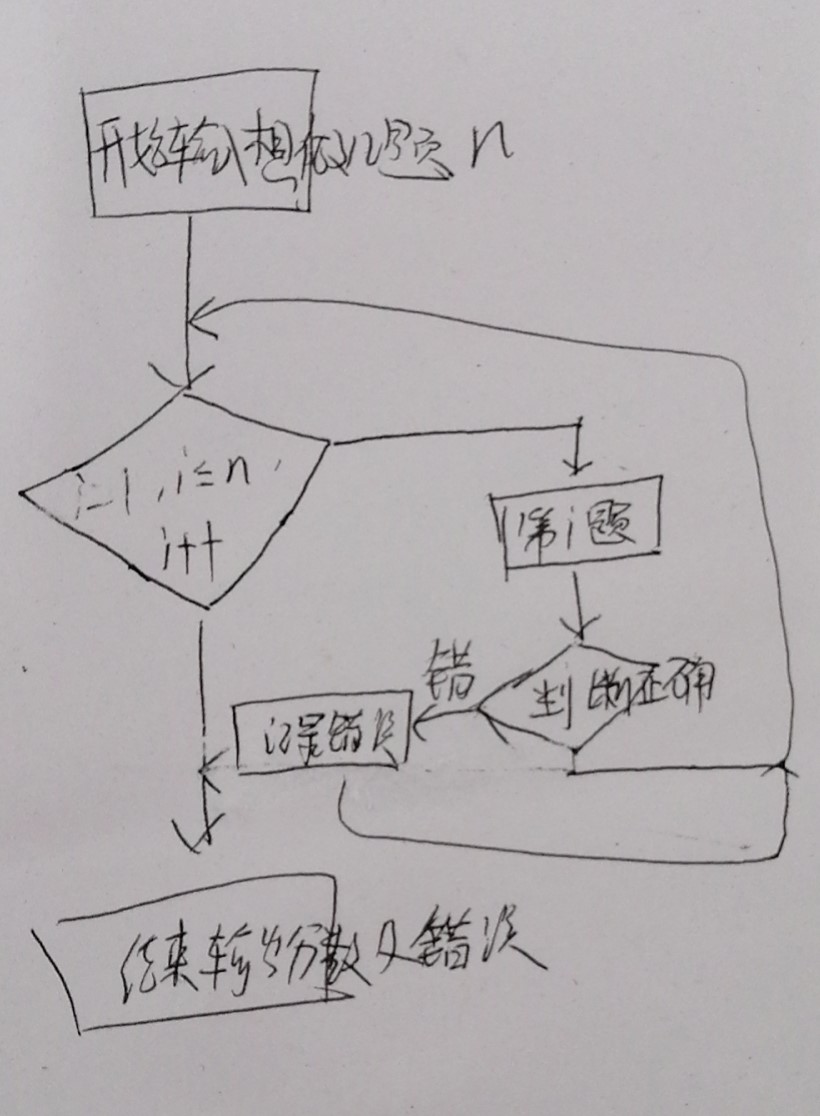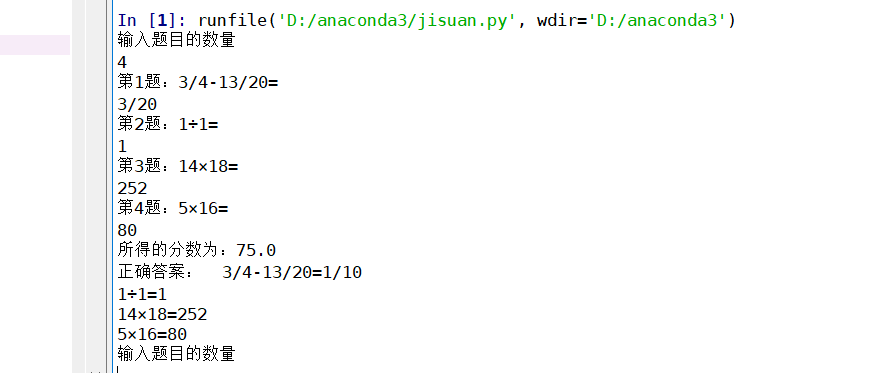python实现四则运算
https://github.com/history5201/python
在程序的各个模块的开发上耗费的时间PSP表格:
| PSP2.1 | Personal Software Process Stages | 预估耗时(分钟) | 实际耗时(分钟) |
|---|---|---|---|
| Planning | 计划 | 30 | 42 |
| · Estimate | · 估计这个任务需要多少时间 | 30 | 42 |
| Development | 开发 | 305 | 395 |
| · Analysis | · 需求分析 (包括学习新技术) | 20 | 30 |
| · Design Spec | · 生成设计文档 | 25 | 30 |
| · Design Review | · 设计复审 (和同事审核设计文档) | 10 | 15 |
| · Coding Standard | · 代码规范 (为目前的开发制定合适的规范) | 15 | 25 |
| · Design | · 具体设计 | 30 | 45 |
| · Coding | · 具体编码 | 150 | 180 |
| · Code Review | · 代码复审 | 30 | 35 |
| · Test | · 测试(自我测试,修改代码,提交修改) | 25 | 35 |
| Reporting | 报告 | 100 | 110 |
| · Test Report | · 测试报告 | 70 | 65 |
| · Size Measurement | · 计算工作量 | 15 | 25 |
| · Postmortem & Process Improvement Plan | · 事后总结, 并提出过程改进计划 | 15 | 20 |
| 合计 | 435 | 547 |
3)解题思路描述:
在百度以及GitHub上寻找适合的报告书作为参考以及参考网络代码进行修改
4)设计实现过程:
1、定义三个函数:出题函数、判断函数、主函数
2、出题函数:在字符数组[+ - * /]中随机抽取两个或一个符号以及0-30之间抽取随机数进行四则运算
3、判断函数:判断同学从键盘内输入的答案是否正确;
4、主函数:输入一个数值N,以便学生选择做几题,然后循环出题以及判断函数。
流程图如下所示:

5)代码说明:
import random from fractions import Fraction ##两个整数的四则运算 def c1(q, ans): symbol = random.choice(['+', '-', '*', '/']) # 生成随机符号 if symbol == '+': n1 = random.randint(0, 20) n2 = random.randint(0, 20) q.append(str(n1) + '+' + str(n2) + '=') ans.append(n1 + n2) elif symbol == '-': n1 = random.randint(0, 20) n2 = random.randint(0, 20) n1,n2 = max(n1,n1),min(n1,n2)#防止出现负数 q.append(str(n1) + '-' + str(n2) + '=') ans.append(n1 - n2) elif symbol == '*': n1 = random.randint(0, 20) n2 = random.randint(0, 20) q.append(str(n1) + '×' + str(n2) + '=') ans.append(n1 * n2) else: n1 = random.randint(0, 20) if n1 == 0: n2 = random.randint(1, 20) else: n2 = random.randint(1, n1 + 1) q.append(str(n1) + '÷' + str(n2) + '=') ans.append(Fraction(n1, n2)) ##随机生成两个分数 def createF(): fz1 = random.randint(0, 20) if fz1 == 0: fm1 = random.randint(1, 20) else: fm1 = random.randint(1, 20) f1 = Fraction(fz1, fm1) fz2 = random.randint(1, 20) fm2 = random.randint(20, 20) f2 = Fraction(fz2, fm2) return f1, f2 def f(f):#分数的转换 a=f.numerator #分子 b=f.denominator #分母 if a%b==0:#为整数 return '%d'%(a/b) elif a<b:#为真分数 return '%d%s%d' % (a,'/',b) else:#为带分数 c=int(a/b) a = a - c * b return '%d%s%d%s%d' % (c,'’',a,'/',b) ##两个分数的四则运算 def c2(q,ans): symbol = random.choice(['+','-','*','/']) f1,f2 = createF() if symbol =='+': while f1+f2>1: f1,f2 = createF() q.append(str(f1)+'+'+str(f2)+'=') ans.append(f1+f2) elif symbol =='-': f1,f2 = max(f1,f2),min(f1,f2)#防止出现负数 q.append(str(f1)+'-'+str(f2)+'=') ans.append(f1-f2) elif symbol == '*': while f1*f2>1: f1,f2 = createF() q.append(str(f1)+'×'+str(f2)+'=') ans.append(f1*f2) else: while f1/f2>1: f1,f2=createF() q.append(str(f1)+'÷'+str(f2)+'=') ans.append(Fraction(f1,f2)) def main(): while 1: print("输入题目的数量", end=' ') k = int(input()) p = 100 / k s = 0 q = [] ans = [] ans2 = [] for i in range(k): n = random.randint(1, 4) if n == 1: c1(q, ans) g = Fraction(ans[i]) ans2.append(f(g)) else: c2(q, ans) g = Fraction(ans[i]) ans2.append(f(g))#记录带分数答案 for i in range(k): print("第{}题:{}".format(i + 1, q[i]), end=" ") a = input() if a == str(ans[i]): s = s + p print("所得的分数为:{}".format(s)) print("正确答案:", end=" ") for i in range(k): if str(ans[i]) == str(ans2[i]): print(q[i] + str(ans[i])) else: print("{}{}或{}".format(q[i],str(ans2[i]),str(ans[i]))) if __name__ == '__main__': main()
6)测试运行:

7)你程序中消耗最大的函数:
该函数所需要的空间复杂度最大
def c1(q, ans): symbol = random.choice(['+', '-', '*', '/']) # 生成随机符号 if symbol == '+': n1 = random.randint(0, 20) n2 = random.randint(0, 20) q.append(str(n1) + '+' + str(n2) + '=') ans.append(n1 + n2) elif symbol == '-': n1 = random.randint(0, 20) n2 = random.randint(0, 20) n1,n2 = max(n1,n1),min(n1,n2)#防止出现负数 q.append(str(n1) + '-' + str(n2) + '=') ans.append(n1 - n2) elif symbol == '*': n1 = random.randint(0, 20) n2 = random.randint(0, 20) q.append(str(n1) + '×' + str(n2) + '=') ans.append(n1 * n2) else: n1 = random.randint(0, 20) if n1 == 0: n2 = random.randint(1, 20) else: n2 = random.randint(1, n1 + 1) q.append(str(n1) + '÷' + str(n2) + '=') ans.append(Fraction(n1, n2)) ##随机生成两个分数 def createF(): fz1 = random.randint(0, 20) if fz1 == 0: fm1 = random.randint(1, 20) else: fm1 = random.randint(1, 20) f1 = Fraction(fz1, fm1) fz2 = random.randint(1, 20) fm2 = random.randint(20, 20) f2 = Fraction(fz2, fm2) return f1, f2



